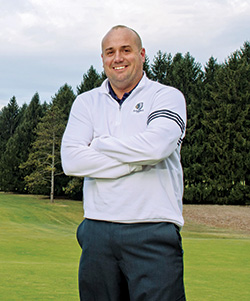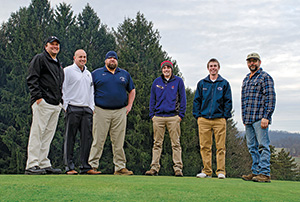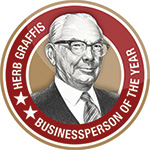Jimmy the Kid
 Range picker at 14… Superintendent at 24… Director of operations by 28… How Schuylkill CC’s decision to hire the local kid paid off.
Range picker at 14… Superintendent at 24… Director of operations by 28… How Schuylkill CC’s decision to hire the local kid paid off.
It was a courtesy interview that made everything else possible: a career would be born; a private club would be revitalized; and a Donald Ross gem would be restored.
Jim Rattigan (Jimmy to many) was the 14-year-old kid with the A-game who used to work picking balls on the range. When he was 16 he took a job on the crew cutting cups. Even when he left for college — Coastal Carolina first, to try out the PGA Golf Management program, then Penn State to earn a turf degree — he still returned home to work summers on the crew.
So when the superintendent job opened up during his senior year at Penn State, he decided to “throw his hat in the ring and see what happened.” He had little expectation to get an interview.
A week after his interview, the phone rang.
“It went from a courtesy interview to they were going to give me a shot, and I hadn’t even gotten out of school yet,” Rattigan recalls. “It was a whirlwind of excitement… a little bit of fear, but ultimately it was something I was so excited to take on and to do, I couldn’t wait to get here and get started.
Going all-out
From that fateful day in 2002 to today, Rattigan has seen many successes. Now add to that list the 2014 Herb Graffis Businessperson of the Year Award, named in honor of Golfdom’s founder, Herb Graffis, who started the magazine in 1927 (see sidebar, page 19.)
A lot of things happened fast for Rattigan. He was only 24 when he was offered the job at Schuylkill (pronounced SKOOK-uhl), a Donald Ross/Willie Park Jr. designed private club in sleepy central Pennsylvania. It was then a quick six years later that he was promoted to general manager, taking on the title of director of operations/superintendent.
Before he applied for the superintendent position, Rattigan discussed the possibility at length with the late George Hamilton, his professor at Penn State who convinced him to leave Coastal Carolina to pursue a turf degree over a career as a PGA Professional. They agreed it couldn’t hurt to apply, but if he did get a courtesy interview, he should go all-out in order to respect the opportunity.
Rattigan entered the interview room with a projector and laptop, both borrowed from Hamilton, and a nothing-to-lose attitude.
“A couple things stood out about Jimmy: first and foremost, his excellent academic record,” recalls Joe Troy, a Pennsylvania attorney and a longtime member of Schuylkill CC. Troy was one of the members in the room that day.
“His knowledge and commitment to Schuylkill didn’t hurt, either,” Troy continues. “Then there was the fact that he was close to a scratch golfer, so he knew how the course should play viewed from a golfer’s perspective. Lastly, he had done an internship with (architect and Donald Ross expert) Ron Prichard at Aronimink, so he had an appreciation for the historical aspect of this Donald Ross course.”
He hasn’t told anyone this before, but Jimmy also had a secret weapon: he had just picked up some tricks from one of the best in the business, fellow Penn State alumnus Mark Kuhns, CGCS at Baltusrol.
“(Kuhns) came to the turf club and did a presentation for the turf students on how he did his interview when he went to Baltusrol — things to think about, questions and some neat little tricks,” Rattigan recalls with a sly smile. “I paid attention to that and I actually implemented quite a few of them in my interview.”
It all added up to the opportunity of a lifetime. Rattigan was now a superintendent at age 24, before he had even graduated from Penn State. Once he graduated he moved back in with his parents, sleeping on their couch for the first six months while he again went “all-out” making as many improvements as quickly as he could to his home course.
Small club, small budget
Just because he got a shot didn’t mean he’d make it work. Once again, Hamilton helped.
“George, we sat down and had a real long meeting. I brought him in for a visit… he was the guy I leaned on. He helped me put together some programs,” Rattigan says. “Having a guy like that was a huge help. He was the biggest influence in me getting into the business and getting off on the right foot.”
According to Roy Heim, owner of Heim Construction and a member at Schuylkill since 1998, the conditions have gone from average to superb on Rattigan’s watch.
“It’s the closest thing to Pinehurst No. 2 I’ve ever played,” says Heim, comparing the course to a legendary Ross course and host of this year’s men’s and women’s U.S. Opens. “I went to Pinehurst and the caddie was trying to give me reads. I told him, ‘I’ve got it.’ I putted well that day and the caddie said ‘Wow, I’m not used to seeing someone read the greens this well.’ I told him, ‘We’ve got the same thing back home.’”
That’s a bold statement considering Rattigan took over a course that, when he was hired, didn’t own a grinder.
“When I walked into the door, there were some interesting challenges. We really were hurting on the equipment side,” Rattigan recalls. “When I was interning at Aronimink, I made good friends with the mechanic, Muhamed “Hamo” Krkbesevic. He’s a brilliant mechanic, and a really good guy. I had him come up, we went through all the equipment together, he helped me find some grinders, trained our guys how to use them, and that really took us to the next level.”
Will Schneider, assistant superintendent, has been at the course for 17 years, and says the equipment has never been better than it has these last five.
“It’s the worst when you don’t have good equipment, but Jim’s been getting us better and newer equipment,” he says. “With the money situation, needing to keep costs down, we’re doing pretty good. I wouldn’t still be here for 17 years if this wasn’t a great place to work.”
The crew, which ranges from five to 15 depending on the season, gets it done with a maintenance budget of $470,000.
“Walking into a smaller club with a smaller budget, there wasn’t a lot of new equipment,” Rattigan says. “Those first four years were the toughest, trying to get everything here that we needed. Buying used equipment, three-year off-lease stuff… There are a lot of equipment dealers out there, we would pick and choose deals to get what we needed through the door. Now we have what we need, and a couple backups.”
Restoring Ross
Also a concern: this Donald Ross course was losing its Ross characteristics.
Bringing back Ross’ design elements was always a wish of Rattigan’s, and now he was empowered to try to make it happen. He picked up the phone to reintroduce himself to respected Ross historian and golf course architect Ron Prichard.
“Jim had heard about me, called me up and introduced himself over the phone. I only live about 60 miles away, so I traveled up to take a look at (the course),” Prichard recalls. “I spent time with Jim, and I was particularly impressed by him. At the time the club was not well financed, so I told Jim I’d be happy to do it on a gratis basis, work with them as best I could.”
Prichard teamed up with Rattigan and the late Roger Hornberger, a longtime greens committee member who was a geologist with a passion for golf course architecture. The team came up with a plan to remove trees, bring back lost bunkers and probably most important, rebuild a few greens.
“It was a case of a few of the original greens were so steeply pitched — which was justifiable years ago when greens were mowed at much higher heights — that it created a problem where they only had a handful of places they could put a pin from day to day,” Prichard says.
Or, as longtime member Joe Troy says, “We liked to joke that No. 4 was the shortest par 5 in America. The green was so sloped it was impossible to putt. They recontoured it… now it’s still a difficult par 3, but it’s fair.”
Even more exciting to the fiscally minded, Rattigan did much of the work in-house.
“Jimmy would bring in interns from Penn State and make a bunker renovation their assignment. Sometimes we didn’t have the equipment so we’d have to contract outside help, but he’d always be careful,” Troy says. “Also important, a green would go under construction at the end of one season, and be reopened for play by the middle of the next.”
Greg Stewart, a civil engineer in Orwigsburg, Pa., and one of Schuylkill’s new members, says the restoration efforts have made what he calls a “hidden treasure” even more fun to play.
Well, most of the time.
“The tree program has been great and has opened up some spectacular views. Taking the greens back to the original design has been fantastic,” he says. “But they brought back one of Ross’ original greenside bunkers on No. 7. I hit in there the other day, I get in the bunker and I can’t even see the green! I took a photo with my phone and sent it to Jim with a ‘REALLY!?!’ He texted back and said, ‘HAHA, you’re my first victim!’”
Director of operations
It is said that success breeds success, and the many improvements Rattigan had made on the course was about to be rewarded — and challenged — again.
It was the 4th of July, 2007, a mere six years into his tenure at Schuylkill when he was approached by the club president to take a ride on the course. During the ride, Rattigan was told a change was being made, and they’d need him to take over management of the entire club while they searched for a new general manager.

Assistant superintendent Will Schneider, Rattigan, John Sanders, Kevin Peiffer, second assistant Bob Dohner and mechanic George Toback. Photo: Jim Rattigan
His staff went from seven to 50 — from managing the maintenance facility to managing the pro shop, restaurant, membership and events.
“I didn’t know anything about running a restaurant and all that, but I looked at it from a customer’s perspective — if I was walking through the door, what would I see? What would I like to have? That was basically the perspective I tried to keep,” Rattigan says.
Three months passed. Rattigan was learning more everyday. Promotions were made, along with a few difficult changes. By the time the end-of-the-year financials came in, it appeared 2007 was going to be a successful year for the club.
Following the October board meeting, Rattigan was asked to take the job on a permanent basis. His new title became director of operations/superintendent.
“It was very gutsy for him to take a position he was not trained to do. As a superintendent, he’s knowledgeable and can out-work anyone,” Heim says of Rattigan. “As a general manager, he understands that what he doesn’t know, he can research, and he’ll call every person in the world until he does know.”
Since taking the new position, Rattigan has become an expert on making quick changes from golf casual to business professional.
“There are some really long days there between the two, trying to be both places when you need to be. In the summertime I‘ll be out there pulling hoses, just like the rest of the guys. Then I do a quick change, come inside, walk around the restaurant,” Rattigan says. “I’ll go in at night and watch the sprinklers, making sure everything is going on. Then I come in early and set up a spray. I’ll be here in the night until 10 o’clock to lock up the doors after the restaurant closes.”
Hometown hero
Hard to believe that Rattigan, who turned 36 on Christmas Eve, has been working at the course for 22 years now.
“I never thought of it like that,” Rattigan says, considering the years that have passed since he was the range picker. “I hardly golfed when I first started. I was just the kid who was always hanging around, so one day they gave me something to do.”
Rattigan has grown up on this course. He went from the kid who was always hanging around to the director of operations/superintendent at Schuylkill Country Club. It’s no stretch to say he’s also the favorite son of Schuylkill Country Club.
“There’s no more of a hometown hero than you can get than with Jim and Schuylkill,” says Stewart. The two knew each other in high school, and both worked at the club growing up. “As soon as he could drive, he was always there. On weekends, he’d always be running over to water, to cut cups. He was always dedicated to that course. He was appointed superintendent right out of college, mainly because of his dedication. People who don’t know him, who think he’s just the general manager? He’s actually paid his dues more than anybody out there.”
“You just gravitate to people who are fun and nice,” Rattigan says. “When I was a kid, the members would say, ‘There’s little Jimmy Rattigan!’ and pat me on the head.”
Jimmy the kid has grown up. And the boy’s done good.
 The Herb Graffis Businessperson of the Year award is named in honor of Golfdom’s founder, World Golf Hall of Fame member Herb Graffis. Graffis was one of the first people to look at golf as a business when he and his brother Joe founded Golfdom in 1927. With his foresight, Graffis helped advance the game in numerous ways, from co-founding the National Golf Foundation and founding the Golf Writers Association of America to his work advocating on behalf of superintendents and helping elevate their profile.
The Herb Graffis Businessperson of the Year award is named in honor of Golfdom’s founder, World Golf Hall of Fame member Herb Graffis. Graffis was one of the first people to look at golf as a business when he and his brother Joe founded Golfdom in 1927. With his foresight, Graffis helped advance the game in numerous ways, from co-founding the National Golf Foundation and founding the Golf Writers Association of America to his work advocating on behalf of superintendents and helping elevate their profile.
The award includes a Golfdom cover story celebrating the person’s accomplishments, as well as expenses-paid trips to both the Golfdom Summit and the Golf Industry Show. It is in all due respect that we present this award in Mr. Graffis’ honor.












